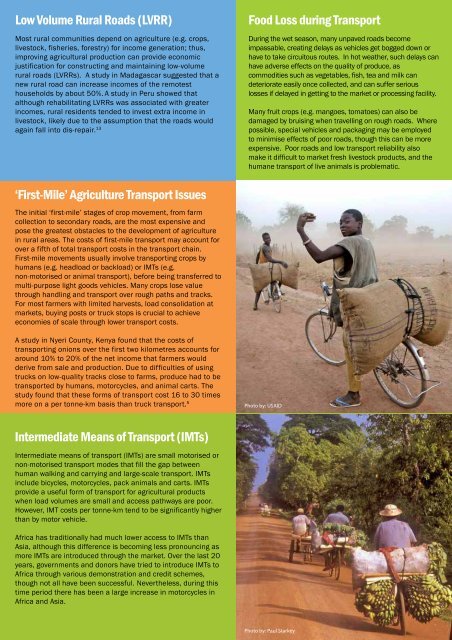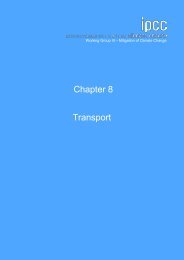Rural Transport and Agriculture Fact Sheet
recap_factsheet_2_-_final_-_english
recap_factsheet_2_-_final_-_english
Create successful ePaper yourself
Turn your PDF publications into a flip-book with our unique Google optimized e-Paper software.
Low Volume <strong>Rural</strong> Roads (LVRR)<br />
Most rural communities depend on agriculture (e.g. crops,<br />
livestock, fisheries, forestry) for income generation; thus,<br />
improving agricultural production can provide economic<br />
justification for constructing <strong>and</strong> maintaining low-volume<br />
rural roads (LVRRs). A study in Madagascar suggested that a<br />
new rural road can increase incomes of the remotest<br />
households by about 50%. A study in Peru showed that<br />
although rehabilitating LVRRs was associated with greater<br />
incomes, rural residents tended to invest extra income in<br />
livestock, likely due to the assumption that the roads would<br />
again fall into dis-repair. 13<br />
Food Loss during <strong>Transport</strong><br />
During the wet season, many unpaved roads become<br />
impassable, creating delays as vehicles get bogged down or<br />
have to take circuitous routes. In hot weather, such delays can<br />
have adverse effects on the quality of produce, as<br />
commodities such as vegetables, fish, tea <strong>and</strong> milk can<br />
deteriorate easily once collected, <strong>and</strong> can suffer serious<br />
losses if delayed in getting to the market or processing facility.<br />
Many fruit crops (e.g. mangoes, tomatoes) can also be<br />
damaged by bruising when travelling on rough roads. Where<br />
possible, special vehicles <strong>and</strong> packaging may be employed<br />
to minimise effects of poor roads, though this can be more<br />
expensive. Poor roads <strong>and</strong> low transport reliability also<br />
make it difficult to market fresh livestock products, <strong>and</strong> the<br />
humane transport of live animals is problematic.<br />
‘First-Mile’ <strong>Agriculture</strong> <strong>Transport</strong> Issues<br />
The initial ‘first-mile’ stages of crop movement, from farm<br />
collection to secondary roads, are the most expensive <strong>and</strong><br />
pose the greatest obstacles to the development of agriculture<br />
in rural areas. The costs of first-mile transport may account for<br />
over a fifth of total transport costs in the transport chain.<br />
First-mile movements usually involve transporting crops by<br />
humans (e.g. headload or backload) or IMTs (e.g.<br />
non-motorised or animal transport), before being transferred to<br />
multi-purpose light goods vehicles. Many crops lose value<br />
through h<strong>and</strong>ling <strong>and</strong> transport over rough paths <strong>and</strong> tracks.<br />
For most farmers with limited harvests, load consolidation at<br />
markets, buying posts or truck stops is crucial to achieve<br />
economies of scale through lower transport costs.<br />
A study in Nyeri County, Kenya found that the costs of<br />
transporting onions over the first two kilometres accounts for<br />
around 10% to 20% of the net income that farmers would<br />
derive from sale <strong>and</strong> production. Due to difficulties of using<br />
trucks on low-quality tracks close to farms, produce had to be<br />
transported by humans, motorcycles, <strong>and</strong> animal carts. The<br />
study found that these forms of transport cost 16 to 30 times<br />
more on a per tonne-km basis than truck transport. 5<br />
Photo by: USAID<br />
Intermediate Means of <strong>Transport</strong> (IMTs)<br />
Intermediate means of transport (IMTs) are small motorised or<br />
non-motorised transport modes that fill the gap between<br />
human walking <strong>and</strong> carrying <strong>and</strong> large-scale transport. IMTs<br />
include bicycles, motorcycles, pack animals <strong>and</strong> carts. IMTs<br />
provide a useful form of transport for agricultural products<br />
when load volumes are small <strong>and</strong> access pathways are poor.<br />
However, IMT costs per tonne-km tend to be significantly higher<br />
than by motor vehicle.<br />
Africa has traditionally had much lower access to IMTs than<br />
Asia, although this difference is becoming less pronouncing as<br />
more IMTs are introduced through the market. Over the last 20<br />
years, governments <strong>and</strong> donors have tried to introduce IMTs to<br />
Africa through various demonstration <strong>and</strong> credit schemes,<br />
though not all have been successful. Nevertheless, during this<br />
time period there has been a large increase in motorcycles in<br />
Africa <strong>and</strong> Asia.<br />
Photo by: Paul Starkey



